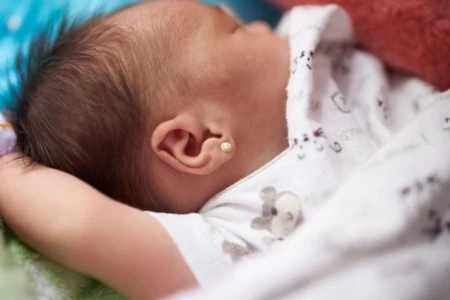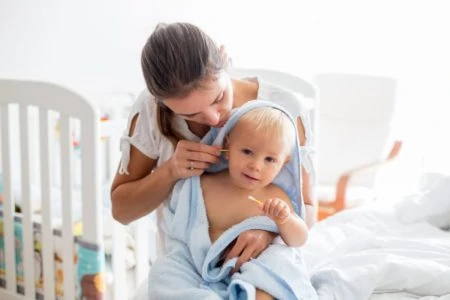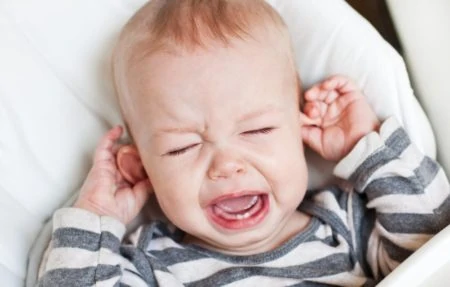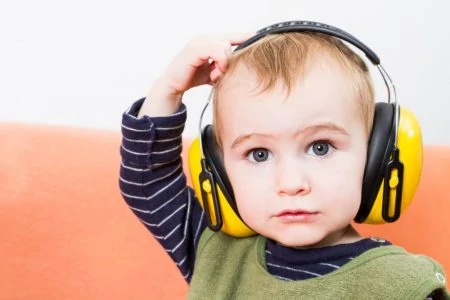Piercing a baby’s ears is one of those parenting topics that tends to divide a room. You might view it as a beautiful cultural tradition, while your neighbor sees it as an unnecessary risk.
We have been in your position, and we are here to help you cut through the noise.
With guidance from experienced pediatricians, we will break down the arguments for and against baby ear piercing. We will cover the safety facts, the best timing, and how to handle the aftercare if you decide to proceed.
Key Takeaways
- Personal choice: Ear piercing is usually an elective procedure based on cultural tradition or family preference rather than medical necessity.
- Know the risks: Potential complications include infection, allergic reactions to metals, embedded earrings, and keloid scarring.
- Professional care: Experts recommend having a pediatrician perform the piercing using sterile needles rather than using mall kiosks with piercing guns.
- Diligent aftercare: You must clean the area daily, rotate the studs, and monitor for redness or swelling to prevent infection.
Why Do Some Parents Do It?
For many families, piercing a baby’s ears is simply non-negotiable. It is a matter of heritage, family tradition, or aesthetics.
Some parents choose to do it because it looks cute. Others use earrings as a clear gender marker so strangers stop calling their baby girl a “handsome boy.”
Cultural values play a massive role here. In many Latin American, Indian, and Southern European cultures, it is standard practice to pierce a baby girl’s ears shortly after birth.
Some families have a relative perform the piercing at home, while others prefer a pediatrician do it before the baby leaves the hospital (1). Even if parents wait to let the child decide later, the cultural pull is often so strong that the child eventually requests it anyway.
What Do the Experts Say?
If you ask medical providers, the first response is usually that this is an elective procedure. It is not necessary for the health of your child.
The American Academy of Pediatrics (AAP) states that ear piercing is safe at any age if performed with sterile equipment and proper aftercare. However, they recommend waiting until the child is old enough to manage the care themselves.
As with any procedure, you must weigh the risks against the benefits before making a decision.
Benefits
There are a few reasons why parents opt to get it done early:
- Tradition: It fulfills important family or cultural expectations.
- Pain memory: Many believe piercing an infant’s ears is kinder because they won’t remember the momentary pain, unlike an older child.
- Hygiene control: Parents are fully in charge of cleaning the ears, ensuring the aftercare is done correctly.
- Gender identification: Society easily identifies the baby as a girl.
- Aesthetics: The family enjoys the cosmetic appearance of the earrings.
Potential Risks
Your pediatrician will likely bring up several safety concerns for you to consider:
1. Infection
Infection is the most common side effect. This can range from mild redness to a painful abscess that requires drainage.
- Bacteria introduction: Piercing the skin creates an entry point for surface bacteria (like Staph) to multiply.
- Dirty hands: Babies constantly touch their faces and mouths, easily transferring germs to their earlobes.
- Immune system: A baby’s immune system is still developing, making them more susceptible to infections.
- Bloodborne pathogens: Though rare, there have been reports of Hepatitis B and C spreading through unsterile piercing equipment (2).
- Medical conditions: If your baby has congenital heart disease or an immune deficiency, an infection could be dangerous. In these cases, doctors strongly advise waiting.
2. Trauma
Babies are wiggly and uncoordinated. It is common for them to accidentally rip the tissue by pulling on a shiny earring. Clothing, blankets, and towels can also snag on the stud, potentially tearing the delicate earlobe.
3. Embedded Earring
If the earring back is too tight or the earlobe swells, the metal can become embedded inside the tissue. This often happens with spring-loaded guns that clamp down too hard. It causes significant pain and usually requires a doctor to remove the jewelry.
4. Aspiration
This is a scary but real risk. As babies develop their pincer grasp, they pick up everything to put it in their mouths.
If an earring comes loose, your baby could swallow it or, worse, inhale it into their lungs (aspiration). This is a medical emergency (3). This is why locking backs or safety screw-backs are essential for infants.
5. Allergic Reactions
Metal allergies are common. Nickel, often found in lower-quality gold or steel, causes contact dermatitis. This results in red, itchy, crusty skin that is uncomfortable for the baby and increases the risk of infection.
6. Scarring
Some bodies are prone to keloids, which are thick, raised scars that grow beyond the original wound. It is impossible to predict if your baby will develop keloids. If they do, the scar tissue is permanent and difficult to treat.
7. Asymmetry
Babies have tiny earlobes that grow as they age. A piercing that looks centered on an infant might end up looking high or uneven by the time they are five years old. Plus, babies move during the procedure, which increases the risk of crooked holes.
If You Decide to Go Ahead With the Piercing
If you have weighed the pros and cons and decided to proceed, preparation is key. Here is how to ensure the process is safe and smooth.
Who Should Pierce My Child’s Ears?
Skip the mall kiosk. The safest option for a baby is a pediatrician or a medical professional who offers the service (4).
Retail stores often use piercing guns, which cannot be fully sterilized. This increases the risk of transmitting diseases like Hepatitis. Furthermore, store employees usually lack medical training.
Pediatricians generally use sterile, single-use needles or medical-grade piercing cassettes. They can provide a more hygienic environment and are trained to handle squirming infants.
Will It Hurt My Baby?
Yes, it will hurt, but only for a moment.
Doctors generally do not give anesthetic shots because the shot itself hurts as much as the piercing. However, you can ask your pediatrician to apply a topical anesthetic (numbing cream) to the earlobes 30 minutes prior. This significantly reduces the pain.
To help the process:
- Hold them tight: A secure hold prevents movement and crooked piercings.
- Distract them: Have a bottle, pacifier, or favorite toy ready for immediately after the poke.
- Stay calm: Your baby feeds off your energy. If you are anxious, they will be too.
Caring for the Area After Piercing
Consistent aftercare is the only way to prevent infection. You will typically need to leave the initial earrings in for at least six weeks (5).
Follow these steps for proper healing:
- Clean twice daily: Use rubbing alcohol or an antiseptic solution recommended by your doctor. Apply it to the front and back of the lobe.
- Rotate the studs: Gently twist the earrings at least once a day to prevent them from sticking to the healing skin.
- Dry thoroughly: Bacteria love moisture. After bath time, use a clean towel to pat the earlobes dry.
- Check the backing: Ensure the earring back is not pushed too tight against the ear. There should be air circulation to allow swelling to subside.
- Monitor daily: Look for redness, pus, or excessive heat. If things look worse rather than better, call your doctor.
- No swimming: Avoid public pools, lakes, or hot tubs while the ears are healing, as these are breeding grounds for bacteria.
When Can I Switch Earrings?
After six weeks, the lobes should be healed enough to change the jewelry. However, you should keep earrings in the holes continuously for the first six months to prevent them from closing up.
When choosing new earrings, prioritize safety:
- Material matters: Stick to 14k gold, surgical titanium, or platinum. Avoid “costume jewelry” that contains nickel.
- Safety backs: Look for “screw-back” earrings. These twist on and lock, making it much harder for a baby to pull them off and choke on them.
- Size and shape: Choose small, flat studs that won’t snag on clothes. Avoid hoops or dangling earrings completely until the child is much older.
Baby Ear Piercing FAQs
In Conclusion
Deciding to pierce your baby’s ears is a personal choice that balances cultural tradition with medical considerations. While the risks are real, they are generally manageable with proper hygiene and professional help.If you choose to move forward, skip the mall and call your pediatrician. Using a medical professional ensures your little one gets the safest, cleanest experience possible.









